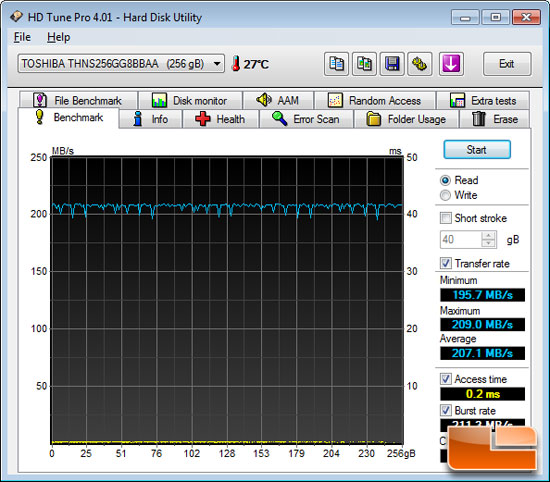Toshiba HG2 43nm 256GB Solid State Drive Review
Free Space, Degradation and Conclusion
Capacity

When it comes to storage capacity, the Toshiba 256GB SSD has a free capacity of 238GB as shown above.
Drive Degradation
An interesting topic is how an SSD performs after it has been abused and completely filled up. The first benchmark that we ran on the Toshiba HG2 series was HD Tune, so after we filled up the drive a few times and used it for a week we went back and re-ran this benchmark to see how bad the performance degraded.

The Toshiba HG2 256GB SSD has a sequential read speed average of 209.8MB/s and you’ll notice that the performance across the drive was fairly smooth with not too many spikes. The average access time was 0.1ms and the burst rate was 211MB/s.

After we were through with testing the drive performance was hardly impacted by our abuse, which is amazing and great to see in a mainstream SSD. The Toshiba HG2 256GB had an average read speed of 207.1MB/s, which is not a significant difference from the starting point. You can see that the read speed had a few more ‘spikes’ across the NAND, but nothing to be concerned about. The access time was slightly up, but the burst rate remained the same at 211MB/s. The Toshiba HG2 series of SSDs appears to do very well when it comes to performance degradation thanks to their proprietary wear leveling algorithm and of course the Windows 7 TRIM command.

Final Thoughts and Conclusions
The 256GB Toshiba HG2 Series drive that we benchmarked proved to be a solid performing mainstream SSD from our testing. The vast majority of file transfers in Windows are sequential read and write data moves and the HG2 had very respectable sequential speeds. For example in ATTO we were able to reach 241MB/s read and 177MB/s write. These are the types of speeds that we would expect for a mainstream SSD in 2010. The Toshiba HG2 Series of SSDs also supports TRIM, which is critical in making sure your drive is performing at the top of its game. If Toshiba were ever to announce the H2G series directly to consumers we could see it doing very well in the mainstream market. For now if you want one of these drives, or at least the components inside, you have a few companies that re-brand these drives. The companies that we know are using the Toshiba 43nm controller would be Kingston in the SSDNow V+ Series (SNV325-S2) and we have also seen it in the Super Talent UltraDrive DX Notebook Series SSD. More manufactures could be using this controller and NAND Flash arrangement, but that is all that we are certain of.
Toshiba isn’t slowing down when it comes to SSD development as they have announced that a 3rd-generation HG3 High Performance SSD is on the way. Toshiba announced during CES 2010 that the HG3 Series will be based on new 32nm Multi-Level Cell NAND and feature higher performance read/write speeds. The upcoming drive has a maximum sequential read speed of 250MB/s and 180MB/s write. The drive that we reviewed here today is nearly at those levels right now, but we don’t know what other optimizations Toshiba made to their upcoming product.
Toshiba has caught our attention in the SSD market and we look forward to seeing how the HG3 series of drives performs later in the year.
Legit Bottom Line: The Toshiba HG2 256GB SSD had solid performance numbers with minimal performance degradation and is ideal for the mainstream consumer market.

Comments are closed.